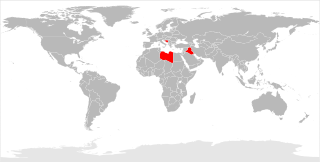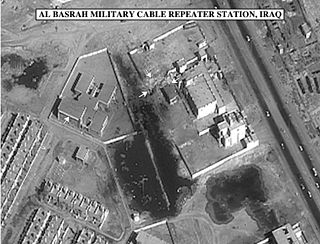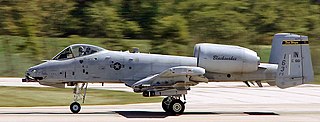Related Research Articles

The United States Air Force (USAF) is the air service branch of the United States Armed Forces. It is one of the eight U.S. uniformed services. Initially formed as a part of the United States Army on 1 August 1907, the USAF was established as a separate branch of the U.S. Armed Forces on 18 September 1947 with the passing of the National Security Act of 1947. It is the second youngest branch of the U.S. Armed Forces and the fourth in order of precedence. The U.S. Air Force articulates its core missions as air superiority, global integrated intelligence, surveillance and reconnaissance, rapid global mobility, global strike, and command and control.
Electronic warfare (EW) is any action involving the use of the electromagnetic spectrum or directed energy to control the spectrum, attack an enemy, or impede enemy assaults. The purpose of electronic warfare is to deny the opponent the advantage of, and ensure friendly unimpeded access to the EM spectrum. EW can be applied from air, sea, land, and/or space by manned and unmanned systems, and can target communication, radar, or other assets.
Military doctrine is the expression of how military forces contribute to campaigns, major operations, battles, and engagements.
Aerial warfare is the use of military aircraft and other flying machines in warfare. Aerial warfare includes bombers attacking enemy installations or a concentration of enemy troops or strategic targets; fighter aircraft battling for control of airspace; attack aircraft engaging in close air support against ground targets; naval aviation flying against sea and nearby land targets; gliders, helicopters and other aircraft to carry airborne forces such as paratroopers; aerial refueling tankers to extend operation time or range; and military transport aircraft to move cargo and personnel. Historically, military aircraft have included lighter-than-air balloons carrying artillery observers; lighter-than-air airships for bombing cities; various sorts of reconnaissance, surveillance and early warning aircraft carrying observers, cameras and radar equipment; torpedo bombers to attack enemy shipping; and military air-sea rescue aircraft for saving downed airmen. Modern aerial warfare includes missiles and unmanned aerial vehicles. Surface forces are likely to respond to enemy air activity with anti-aircraft warfare.

A no-fly zone, also known as a no-flight zone (NFZ), or air exclusion zone (AEZ), is a territory or area established by a military power over which certain aircraft are not permitted to fly. Such zones are usually set up in an enemy power's territory during a conflict, similar in concept to a aerial demilitarized zone, and usually intend to prohibit the country's military aircraft from operating in the region. Aircraft that violate a no-fly zone may be shot down by the enforcing state, depending on the terms of the NFZ. Air exclusion zones and anti-aircraft defences are sometimes set up in a civilian context, for example to protect sensitive locations, or events such as the 2012 London Olympic Games, against terrorist air attack.

Suppression of Enemy Air Defenses (SEAD, pronounced ), also known in the United States as "Wild Weasel" and (initially) "Iron Hand" operations, are military actions to suppress enemy surface-based air defenses, including not only surface-to-air missiles (SAMs) and anti-aircraft artillery (AAA) but also interrelated systems such as early-warning radar and command, control and communication (C3) functions, while also marking other targets to be destroyed by an air strike. Suppression can be accomplished both by physically destroying the systems or by disrupting and deceiving them through electronic warfare. In modern warfare SEAD missions can constitute as much as 30% of all sorties launched in the first week of combat and continue at a reduced rate through the rest of a campaign. One quarter of American combat sorties in recent conflicts have been SEAD missions.

Barksdale Air Force Base is a United States Air Force base in northwest Louisiana, United States, in Bossier Parish. It is contiguous to Bossier City, Louisiana, along the base's western and northwestern edge. Barksdale Air Force Base occupies more than 22,000 acres (89 km2) east of Bossier City and along the southern edge of Interstate 20. More than 15,000 active-duty and Air Force Reserve members serve at Barksdale.
Offensive counter-air (OCA) is a military term for the suppression of an enemy's military air power, primarily through ground attacks targeting enemy air bases: disabling or destroying parked aircraft, runways, fuel facilities, hangars, air traffic control facilities and other aviation infrastructure. Ground munitions like bombs are typically less expensive than more sophisticated air-to-air munitions, and a single ground munition can destroy or disable multiple aircraft in a very short time whereas aircraft already flying must typically be shot down one at a time. Enemy aircraft already flying also represent an imminent threat as they can usually fire back, and therefore destroying them before they can take off minimizes the risk to friendly aircraft.

A hardened aircraft shelter (HAS) or protective aircraft shelter (PAS) is a reinforced hangar to house and protect military aircraft from enemy attack. Cost considerations and building practicalities limit their use to fighter size aircraft.

Incirlik Air Base is a Turkish air base of slightly more than 3320 ac, located in the İncirlik quarter of the city of Adana, Turkey. The base is within an urban area of 1.7 million people, 10 km (6 mi) east of the city core, and 32 km (20 mi) inland from the Mediterranean Sea. The United States Air Force and the Turkish Air Force are the primary users of the air base, although it is at times also used by the Royal Air Force and the Royal Saudi Air Force. The base is also the home of the 74th Anti-aircraft Artillery Regiment of the Spanish Army.

Operation Deny Flight was a North Atlantic Treaty Organization (NATO) operation that began on 12 April 1993 as the enforcement of a United Nations (UN) no-fly zone over Bosnia and Herzegovina. The United Nations and NATO later expanded the mission of the operation to include providing close air support for UN troops in Bosnia and carrying out coercive air strikes against targets in Bosnia. Twelve NATO members contributed forces to the operation and, by its end on 20 December 1995, NATO pilots had flown 100,420 sorties.
Shock and awe is a tactic based on the use of overwhelming power and spectacular displays of force to paralyze the enemy's perception of the battlefield and destroy their will to fight. Though the concept has a variety of historical precedents, the doctrine was explained by Harlan K. Ullman and James P. Wade in 1996 and was developed specifically for application by the US military by the National Defense University of the United States.

Bomb damage assessment (BDA), also known as battle damage assessment, is the practice of assessing damage inflicted on a target from a stand-off weapon, most typically a bomb or air launched missile. It is part of the larger discipline of combat assessment. Assessment is performed using many techniques including footage from in-weapon cameras, gun cameras, forces on the ground near the target, satellite imagery and follow-up visits to the target. Preventing information on battle damage reaching the enemy is a key objective of military censorship. For nuclear weapons special techniques may be required due to the extensive damage caused and difficulty in approaching the site.
Effects-based operations (EBO) is a United States military concept that emerged during the Persian Gulf War for the planning and conduct of operations combining military and non-military methods to achieve a particular effect. An effects-based approach to operations was first applied in modern times in the design and execution of the Desert Storm air campaign of 1991. The principal author of the daily attack plans—then Lt Colonel, now retired Lt General David A. Deptula—used an effects-based approach in building the actual Desert Storm air campaign targeting plan. Deptula describes the background, rationale, and provides an example of how an effects-based approach to targeting was conducted in Desert Storm in the publication, "Effects-Based Operations: Change in the Nature of Warfare." The doctrine was developed with an aim of putting desired strategic effects first and then planning from the desired strategic objective back to the possible tactical level actions that could be taken to achieve the desired effect. Contrary to conventional military approaches of force-on-force application that focused on attrition and annihilation, EBO focused on desired outcomes attempting to use a minimum of force. The approach was enabled by advancements in weaponry—particularly stealth and precision weapons—in conjunction with a planning approach based on specific effects rather than absolute destruction. Deptula, speaking at the Gulf War Air Campaign Tenth Anniversary Retrospective, on 17 January 2001 on One Massachusetts Avenue, NW, Washington, DC, defined the goal of EBO; "If we focus on effects, the end of strategy, rather than force-on-force the traditional means to achieve it militarily, that enables us to consider different and perhaps more effective ways to accomplish the same goal quicker than in the past, with fewer resources and most importantly with fewer casualties." Others have postulated that EBO could be interpreted as an emerging understanding that attacking a second-order target may have first order consequences for a variety of objectives, wherein the Commander's intent can be satisfied with a minimum of collateral damage or risk to his own forces.
The United States Air Force became a separate military service on 18 September 1947 with the implementation of the National Security Act of 1947. The Act created the National Military Establishment, later renamed the United States Department of Defense, which was composed of four of the five branches, the Army, Marine Corps, Navy, and a newly created Air Force. Prior to 1947, the responsibility for military aviation was divided between the Army for land-based operations and the Navy and Marine Corps for sea-based operations from aircraft carrier and amphibious aircraft. The Army created the first antecedent of the Air Force on 1 August 1907, which through a succession of changes of organization, titles, and missions advanced toward eventual separation 40 years later. The predecessor organizations leading up to today's U.S. Air Force are:

The 415th Special Operations Squadron is a United States Air Force unit. It is assigned to the 58th Operations Group at Kirtland Air Force Base, New Mexico.

The 163d Fighter Squadron is a unit of the Indiana Air National Guard 122d Fighter Wing located at Fort Wayne Air National Guard Station, Indiana. The 163d is equipped with the A-10 Thunderbolt II.

The 2d Operations Group is the flying component of the United States Air Force 2d Bomb Wing, assigned to the Air Force Global Strike Command Eighth Air Force. The group is stationed at Barksdale Air Force Base, Louisiana.

The 48th Operations Group is the flying component of the 48th Fighter Wing, assigned to the United States Air Forces in Europe – Air Forces Africa. The group is stationed at RAF Lakenheath, England.

The 5th Operations Group is an operational component of the United States Air Force 5th Bomb Wing, stationed at Minot Air Force Base, North Dakota. Its mission is to manage and operate B-52H Stratofortress bombers serve as part of the Air Force's conventional and strategic combat force.
References
- ↑ Dictionary of Military and Associated Terms. US Department of Defense. 2005.
- ↑ target of opportunity
- ↑ Boeing SLAM ER specs incl. notation for targets of opportunity
- ↑ Global Security - Smoke Projectiles incl. vs. targets of opportunity
- ↑ ABC News Australia - Naval operational context
- ↑ Sebastian Cox (1998). The Strategic Air War Against Germany, 1939-1945: Report of the British Bombing Survey Unit. Routledge. p. 4. ISBN 0714647225.
- ↑ Samuel Weber (2009). Targets of Opportunity; On the Militarization of Thinking. Fordham University Press. ISBN 9780823224777.
- ↑ The Military Dictionary. DIANE Publishing. p. 366. ISBN 0941375102. This dictionary was, at the time, the only authorized source of standard terminology for military use by DoD and NATO.